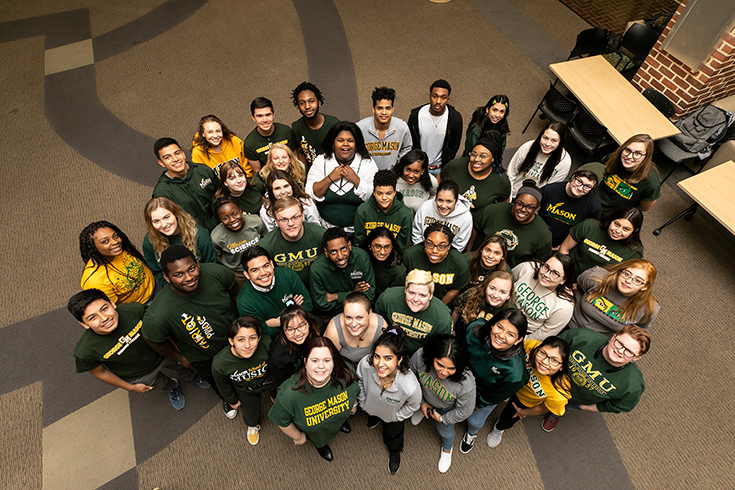
Patriot Leaders will continue helping incoming Mason students transition, but orientation is now in a virtual format. Photo was taken in January by Ron Aira/Creative Services.
Orientation takes on new meanings as we adjust to changing concepts of safety and social interactions. At George Mason University, New Student Orientation helps students navigate the many paths open to them as incoming members of the Mason Nation, now in a virtual format.
Digitizing a program that traditionally uses face-to-face interactions to help students make the connections they need to thrive in a new environment with new responsibilities is an ambitious task. And that is exactly what New Student and Family Programs (NSFP), a department of University Life, has done, all in the space of two months.
“The flexibility and dedication to serve our new students and families and to provide them with this important program in a completely new way has made me so proud to be a part of the Mason community,” said Rick Gray, NSFP Director.
Patriot Leaders and staff worked tirelessly, completing trainings to help navigate new delivery systems on platforms such as Webex, Blackboard, Slack and Mason360. Staff was also trained in the facilitation of small virtual groups, with a focus on non-verbal communication in a virtual space. Planning for Virtual Orientation also required mapping ways in which social media can digitally showcase “Mason Pride.”
Students will experience asynchronous and synchronous offerings on a variety of platforms with the same high quality they would get in an in-person experience. A first-year student attending Mason’s Virtual Orientation will have access to pre-recorded content, with live sessions for advising and registration. Students can also engage in additional Q&A sessions, both general and with a specific focus such as housing or financial aid.
It was also important to design an experience that reminds students Mason’s Virtual Orientation is more than a screen. All freshman students are assigned to a small group to interact with fellow new Patriots. Groups are facilitated by a Patriot Leader and extend throughout the summer. Students can engage with Club Patriot, a series of virtual social events. Live sessions will also allow students to interact with colleges and departments, and start building their own Mason network.
But the work doesn’t end with students. “Family engagement is a key part of student success, and we are delighted to welcome incoming parents and family members into our strong and supportive Mason community,” said Rebecca McCrory, Associate Director of Family Programs. “Virtual orientation provides an opportunity for families to learn about and support their student on their Mason journey.”
Those opportunities come to families in the form of live Q&A sessions, recorded content, and additional presentations created specifically for families.
Every space at Mason that previously had representation in the on-campus orientation was able to create and present high-quality content to students electronically. This content will remain available to them beyond the start of the Fall semester. The creation and execution of Mason’s Virtual Orientation showcases exactly what the experience offers to students, the meaning of working together to maintain community in a virtual world.
Virtual Orientation doesn’t end when the programming is over. There are a number of online resources, including the Mason First Year Resources webpage, that provide easy access to important information and answers to FAQs new students and families will have. Mason360 will also help students stay connected. To strengthen support, Peer Leaders will extend their interactions with the students beyond the end of orientation and into the Fall semester.
“The students realize and remember that they are not alone,” said Peer Leader Bridget Anim. “Although every individual has a different experience, we are all being affected by this pandemic one way or the other and talking about it in a supportive environment helps the new students build connections and be cheerful.”
